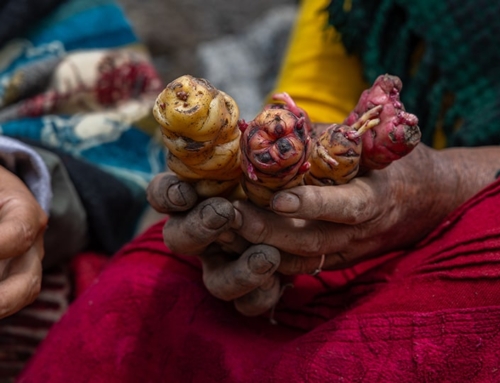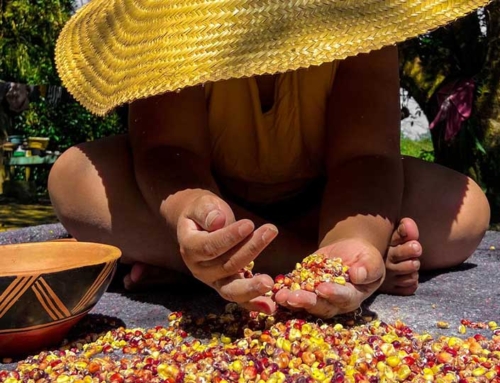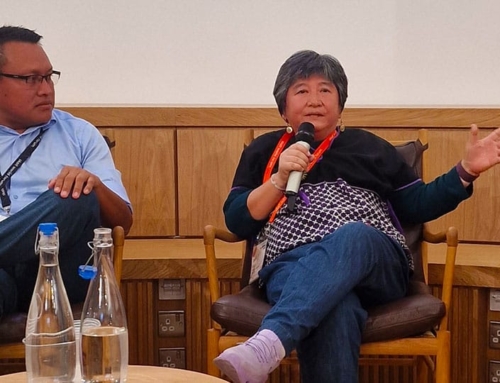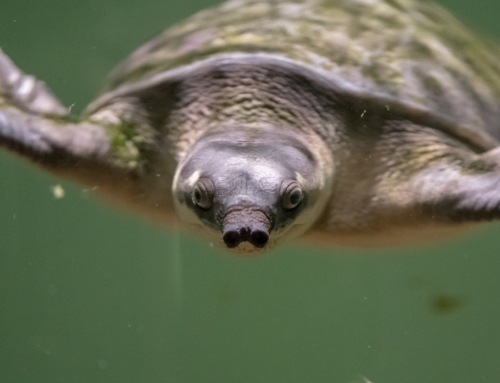The Biocultural Diversity Programme (formerly the Flourishing Diversity Programme) is a new Synchronicity Earth programme that supports partners to defend indigenous and community territories; protect and revive biological and cultural diversity; and try to increase the focus on ‘diversity’ more broadly within conservation and development work and funding. Here, our Head of Biocultural Diversity, Katy Scholfield, talks about the evolution of the programme and some of the exciting partnerships within it.

The promise of ‘development’ and monoculture was also a promise of loss: of ecosystem loss, of biodiversity loss, of economic loss and of loss of culture, community, identity and self-determination.
Yet, on the same trip, I was captivated by the vast variety of colourful products communities sustainably harvest from their forests and I was given hope by the unwavering commitment of these frontline communities to stopping the expansion of industrial palm oil plantations, regardless of ‘development’ promises.
I returned from Liberia feeling ever more committed to supporting partners to challenge monocultures on their lands. But alongside this, I also felt energised to do more to also support the less ‘frontline’ aspects of their work to celebrate and revive indigenous and community lifeways and cultures, to support communities to unify around their own values and goals; and to support and promote an alternative development pathway from the industrial, capitalist model of economic growth.
The seeds of Flourishing Diversity
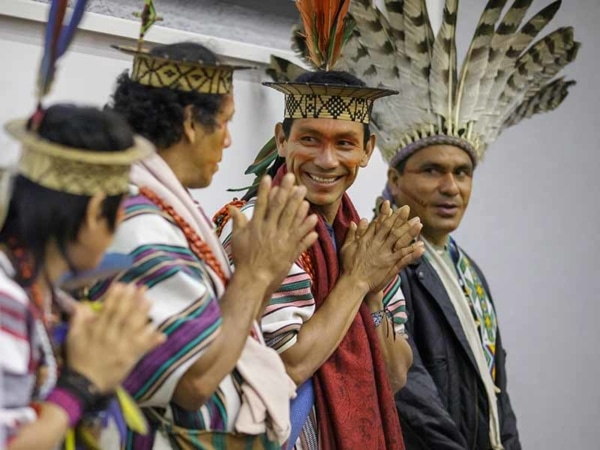
Members of the Ashaninka delegation at the Flourishing Diversity Summit, London, 2019. © Tim Ireland
Synchronicity Earth’s Biocultural Diversity Programme officially grew out of the Flourishing Diversity Series that took place in London in September 2019. The series of events brought together Indigenous Peoples from around the world to share their wisdom with diverse audiences (including university students, conservation organisations, artists, business leaders and many more) about how we can all be better ‘flourishers’ and help to protect and restore the wonderful diversity of earth’s plants, animals and cultures wherever we live in the world. In reality, however, the programme has been in the making at Synchronicity Earth for nearly a decade and is the culmination of side conversations at international conferences, calls with partners across all of our programmes, meetings in NGO (and the Synchronicity Earth) offices, seeing the environmental and social devastation of vast palm oil monoculture plantations in West Africa, discussions over coffee (and cake) in African villages, treks in the Peruvian Amazon and – slightly less exotic – scribbles in notepads on numerous train and tube journeys.

Nature, culture and language are deeply intertwined. Image: The Indigenous Partnership for Agrobiodiversity and Food Sovereignty
Nature, culture and language
Biodiversity, culture and language are deeply intertwined. Throughout history, humans have interacted with nature – and as part of nature – to meet their needs, from food and medicine to spiritual connection and mental wellbeing.
Through these interactions humans have shaped landscapes and nature and their diverse cultures, worldviews, lifeways and languages have been shaped by nature, holding a wealth of information about plants, animals, ecosystems, ecological processes and the relationships and interdependencies between them.
An understanding of and respect for these relationships and the importance of maintaining a balance within them is embedded deeply within the beliefs of most Indigenous Peoples and local communities around the world and reflected in the way they interact with and as part of nature. These interdependencies translate into strong correlations between biological and cultural diversity and are often referred to as ‘biocultural diversity’. They are the reason why the science shows such a huge overlap between where the most plants and animals are found and those areas managed or governed by Indigenous Peoples and local communities according to their customs, beliefs and lifeways.

Margaretha Latekay, a head of the Tala village. Traditional leaders are called the raja and have authority to manage the village and its forest territory in Osi island, West Seram regency, Maluku province, Indonesia. Image: Ulet Ifansasti/CIFOR CC BY-NC-ND 2.0
Dominant monocultures – from the way humans grow their food to the way we educate our children to the languages we speak – are threatening diversity across the world.
This is seen in the palm oil story above; it’s seen in the way industrial fisheries are decimating fish populations in our oceans, whilst at the same time threatening coastal fisher communities’ livelihoods and cultures; it’s seen in the way new policies promoting modern hybrids and genetically modified (GM) seeds and associated chemical products can restrict the production and trade of indigenous, diverse seed and lead to loss of culture and indigenous knowledge on how to protect important sites, as well as the loss of biodiversity and climate resilience.
Our Biocultural Diversity Programme
We’re tackling this threat to biocultural diversity in three ways within our new Biocultural Diversity Programme:
- We’re continuing to support partners to secure their territories and defend them against monocultures and other destructive developments. We’ve supported such work in Central Africa and Papua New Guinea for years and are now expanding this support to parts of Latin America, East Africa and Asia. For instance, we’re supporting LifeMosaic to work with indigenous youth in Peru and Indonesian Papua to protect thousands of hectares of rainforest; and we’re supporting the Chepkitale Ogiek of Kenya to remain on and protect their ancestral forests on the slopes of Mount Elgon.
- We’re supporting groups to revive their cultures, lifeways and languages where they deeply connect with nature. We’ll be writing more about this strand of the work, and some of our new and exciting partnerships, in forthcoming blogs.
- We’re working with and supporting a number of strategic partners to help embed the concept and importance of ‘Flourishing Diversity’ into wider conservation and development work and funding. For instance, some partners can provide a bridge between local partners and diverse audiences using their creative communications skills and wide reaching networks to help show that biological and cultural ‘diversity’, alongside a diversity of approaches, ideas, people, organisations and collaborations, and not uniformity or monoculture, are key to supporting a healthy, resilient planet for all species.
My hope
I have spent the last decade at Synchronicity Earth supporting groups to challenge destructive activity on their territories. This work remains a priority across Synchronicity Earth Programmes. For me personally however, it brings great hope that Synchronicity Earth is evolving its focus to create more space – through funding and alliance building – for Indigenous Peoples and local communities to focus on protecting and reviving their vibrant and diverse languages, lifeways, food systems, seeds, cultures and beliefs alongside their ongoing and tireless struggles for territory.

